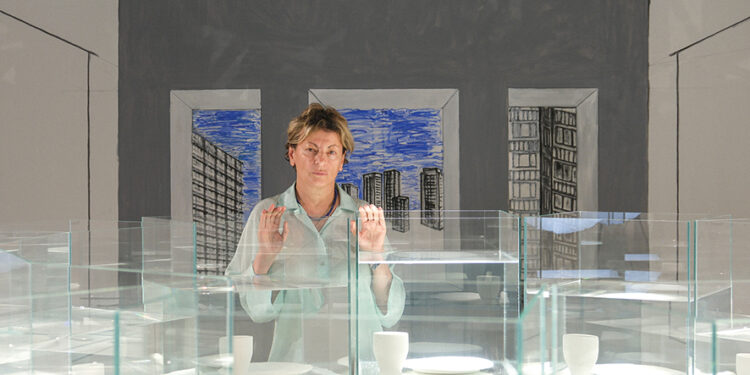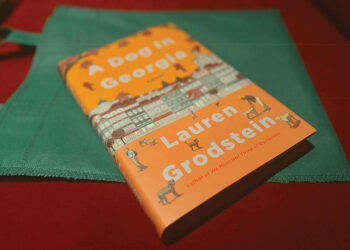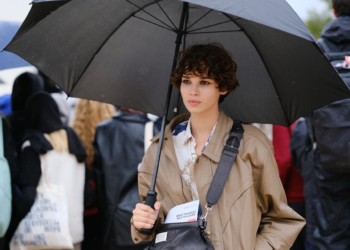Lia Bagrationi, the acclaimed Tbilisi-based contemporary artist, is known for her large-scale installations that draw viewers into quiet, spiralling acts of reflection. Her latest work, “13 Aquariums and a Fish,” offers a similarly meditative and conceptually layered experience. Exploring themes of absence, ritual, and the charged symbolism of the everyday, the installation invites viewers into a space where silence becomes a medium.
We sat down with Lia Bagrationi to delve into the ideas behind this enigmatic project, and the decade-long evolution that led to its creation. Now on view at the Art Foundation Anagi (AFA), the piece has already sparked conversation within Tbilisi’s contemporary art scene.
“13 Aquariums and a Fish” is such a quietly evocative title. What inspired the installation, and how did the idea first come to you?
This idea had been in my mind for about 10 years. At one point, I was considering an exhibition with just a single aquarium and a single fish. But I couldn’t bring the concept to full resolution at the time. Then, when I received an exhibition proposal from the Art Foundation Anagi, I decided to revisit and scale up the idea.
After a conversation with Nana Kipiani (curator of the project, GT), we concluded that there should be thirteen aquariums and one fish. It’s a Gospel-based iconographic scene, but not a historical narrative. It’s a contemporary interpretation.

In a sense, it’s a reimagining of the Last Supper, set in a different kind of present?
Yes, the Last Supper, as a biblical narrative, is something I’ve reinterpreted through a contemporary lens. It’s not just a moment that happened once in the past—it’s a daily reality. Every day, we face the choice to come together or to betray.
How did you arrive at the installation’s visual language?
The installation is arranged in a circle—a form that, in itself, symbolizes continuity. Whenever I’m invited to exhibit, I always take the surrounding space into account. In this case, a circular layout allowed for the most natural expression of line. The circle also embodies repetition—something that returns, again and again.
I wanted to create a sense of stillness, a visual language of silence. A silence that speaks, but silently. Glass represents transparency; water stands for purity and renewal. The only elements inside the aquariums are porcelain vessels crafted by my own hand. These are the sole indicators of my direct presence. There are no figures in this Last Supper. Instead, these vessels serve as quiet traces of those who once were.
One of the guiding motifs for me is premonition. It can be read in many ways, but for me, it’s exactly that—premonition. Speaking about it too much might take us too far afield… But within the work, it manifests subtly. These traces—the porcelain vessels—cast shadows, produce reflections, suggest stillness, even a sense of cold. They might speak of death, or of life—of many things.
The thirteenth aquarium—or perhaps the first—looks identical to the others. But in it there is life, a fish—an ancient Christian symbol, the Ichthys. It is not merely a symbol here: it is a body, made manifest. Its presence does not end. For me, at this moment, it is the only place where life exists. It radiates an energy, one that each viewer may perceive differently, but that unmistakably manifests.
The architectural backdrop—a painted sky, glimpses of modern buildings—what role does that setting play?
In the three windows, I depict modern buildings—landscapes seen from different angles. It’s a way of reframing iconography within a contemporary context. Time becomes displaced, layered. This is happening now. The backdrop is painted on canvas. The sky appears blue and cloudless, but it’s an appliqué and can be removed. Thus, it’s not a constant. That kind of sky might exist today, but not tomorrow. So no, I’m not offering a paradise. The conditions can always change.

How did your collaboration with the Art Foundation Anagi influence the process or final presentation?
I love exhibitions, because they bring an idea into form. They allow me to see it with my own eyes—to realize it. I’m like a writer who keeps editing until a book goes to print. Once it’s printed, that’s it. Once the work is installed, it exists. Of course, I always see things I might have added or changed, but a documented work is fixed in time.
After the opening, I realized this installation would have worked even better in a more intimate, enclosed, darker space, which we tried to approximate. I’m never 100 percent satisfied after a show. I do like it, but exhibitions always reveal new layers. Technically, it was one of the most difficult works I’ve ever created. I’m deeply grateful to the Art Foundation Anagi for making this possible. On my own, it would have been hard to accomplish. I’ve been carrying this idea for 10 years. In short—we worked well together.
And what’s on the horizon for you next?
Starting July 19, my exhibition “Line of Seven, One Missing” will open at the Tunnel exhibition space in the Tsinandali Estate, where it will be on view for a month. I also have other projects in the works… but for now, let’s keep those a mystery.
By Team GT














